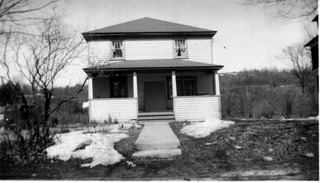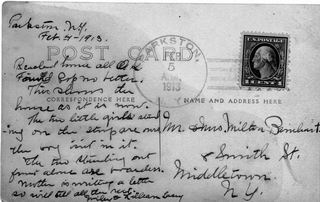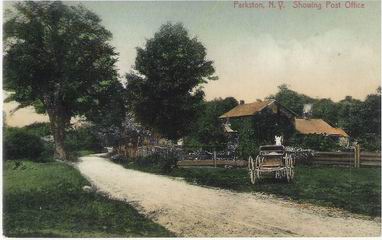 William
Parks and his brothers owned most of the timber rich land in Parkston and
constructed a sawmill. They built a pond for power, houses for its
workers and farms to supply food to the workers. By the
1890's, the timber was depleted and the area became a more of a farming
area with 5 farms covering most of the area. The pond became a easily
available source for ice and several ice houses were built around the
pond.
William
Parks and his brothers owned most of the timber rich land in Parkston and
constructed a sawmill. They built a pond for power, houses for its
workers and farms to supply food to the workers. By the
1890's, the timber was depleted and the area became a more of a farming
area with 5 farms covering most of the area. The pond became a easily
available source for ice and several ice houses were built around the
pond.
George and Matilda Barnhart moved from Dalia and bought the William Parks house and raised their family there farming during the 1890's. At the turn of the century, the area started to be an attraction as to people who wanted to spend the summer in the mountains. Farms like this became boarding houses with easy access from New York City by the way of the O&W railroad. The owners often gave their rooms up in the Summer to make room for more boarders. The population grew and was in need of a post office. The George and Matilda Barnhart farm to the left was used as the post office with George as the Postmaster.
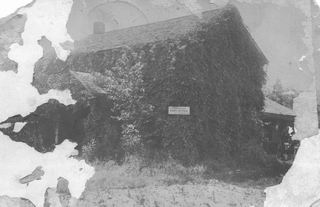 The
picture on the right shows the vine-covered Post office as it appeared in
about 1910. The sign on the corner says Parkston Post Office G. a.
Barnhart P.M. The children of George and Matilda were grown and married
but George was still the Postmaster and Matilda was running a very
profitable boarding house. By this time, the Parkston area had several
farms turned into boarding houses but there was a need for more so George
and Matilda decided to expand the farmhouse to make more room for
boarders. Their daughter Lillian and husband Wiley Lacey came to live and
help too.
The
picture on the right shows the vine-covered Post office as it appeared in
about 1910. The sign on the corner says Parkston Post Office G. a.
Barnhart P.M. The children of George and Matilda were grown and married
but George was still the Postmaster and Matilda was running a very
profitable boarding house. By this time, the Parkston area had several
farms turned into boarding houses but there was a need for more so George
and Matilda decided to expand the farmhouse to make more room for
boarders. Their daughter Lillian and husband Wiley Lacey came to live and
help too.
Money was borrowed and a large addition was added to the back of the building to house many boarders as well as room for the expanding family of Wiley and Lillian Lacey.
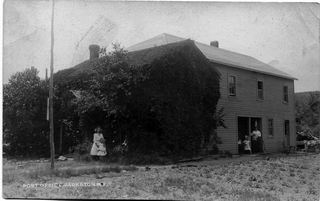 The
Postcard picture to the left is shortly after the addition was completed
in 1913. Matilda had become the Post Master after George became ill.
Lillian Lacey is standing in the doorway to the right with he two oldest
daughters, Vera born 1906 in Livingston Manor and Margaret born 1908 in
Livingston Manor. The two girls in front are summer boarders.
The
Postcard picture to the left is shortly after the addition was completed
in 1913. Matilda had become the Post Master after George became ill.
Lillian Lacey is standing in the doorway to the right with he two oldest
daughters, Vera born 1906 in Livingston Manor and Margaret born 1908 in
Livingston Manor. The two girls in front are summer boarders.
The Postcard was written by Lillian Barnhart Lacey and mailed from Parkston to Milton Barnhart in Middletown who was either a cousin or a brother who has not been identified.
The content of the Postcard: (Postmarked Feb 5, 1913
Parkston)
"Parkston NY Feb 4, 1913
Remodeled home all OK
Found Pop (George Barnhart) no better.
This shows the house as it is now. The two little girls (Vera and
Margaret) are ours - the boy (Clifford) isn't in it.
The two standing out front alone are boarders.
Mother (Matilda) is writing a letter so will tell all the rest.
Wiley and Lillian"
George Barnhart died the next year in 1914 and Matilda continued as the the postmaster and running the boarding house with the help of her daughter Lillian. Wiley was working on the railroad and their sons Clifford and George) took over the job of running the farm. By 1928 they had a total of 12 children and the boarding house business was booming but people were looking for more than a farmhouse to stay in. Four small hotels were built within a mile which attracted some of the more wealthy boarders who wanted swimming pools, tennis courts, Kosher food and other services that were not available from the smaller boarding houses.
The depression of 1929 came and the boarding house business was greatly reduced with only the wealthy going to the hotels. The farm and Wiley's railroad income were hardly enough to pay any rent but as all the others at that time they managed. Matilda Barnhart still owned the house but went to live with her other daughter Greta Lacey Porter and her husband Otis Porter in Middletown. Otis had a body and fender repair shop that was doing well until the depression but went into debt with the risk of losing his business and house.
On July 5th 1935 Edith Gray Decker took Wiley and Lillian
Lacey to a dance and all the Lacey children were playing at the Parkston
House Casino and the ParkstonPO house caught fire and burned almost to the
ground with two unproven theories as the cause:
1. Two of the young Lacey children went back to the house to get some
fireworks from the closet and
started a fire that wasn't noticed for an hour.
2. A car went speeding by the Casino from the Beaverkill road and set fire
to the house. The fire was then discovered shortly after the car went
speeding back. It could have been set fire to collect the insurance which
was held by Matilda Barnhart who was living with Otis Porter and his
ailing car repair business. His business recovered shortly after the fire.
The story that was told was that the green vehicle that was seen was one
and the same that Uncle Otis had and that G-grandmother Barnhart held the
insurance policy and that the Porters benefited from the insurance money.
Interestingly, the Porter's house on Highland Avenue Extension in
Middletown burned in 1945 ten years later due to a chimney fire.
Everything was lost to the fire and the Lacey family had only what they were wearing that day and no place to live. They moved to Parksville next to the railroad tracks over Bagley's house. Lillian got $100 from he Mother Matilda for the contents lost to the fire and Otis gave the kids presents (Bb gun to Harold the youngest).
Shortly
after the fire Matilda gave the farm to Lillian Barnhart Lacey and they mortgaged
the land for materials to build a house. They moved to Old Morsston on the
Beaver Lake road and Sons Clifford and George built most of the house with
the help of a local carpenter Jim Pangram. The porch was a little more
difficult and their Uncle Scott Lacey came from upstate and built the
porch and sidewalk. Even though the house was built in the mid-1930's it
still had an outhouse and icebox for a refrigerator and no electric. The
water was from a hand-pump from a pipe driven i the ground. The family
moved in long before the house was done and they continued to finish the
house. The job of the two youngest boys was to get ice from the
icehouse in the back and load it into the icebox on the back kitchen and
it wasn't until the end of WWII that an electric refrigerator was
purchased and electric wiring was completed after son George came home
from the Army.
The smaller house was built and still stands today and
remained in the family until both sons Clifford and George died in 2001